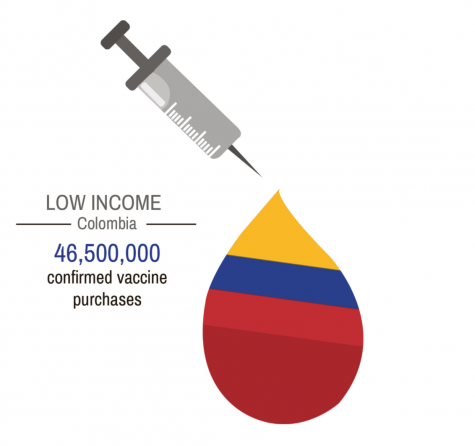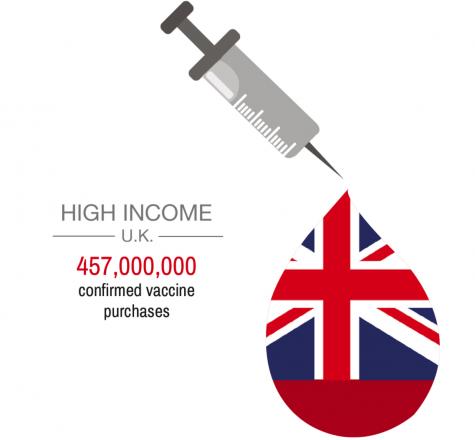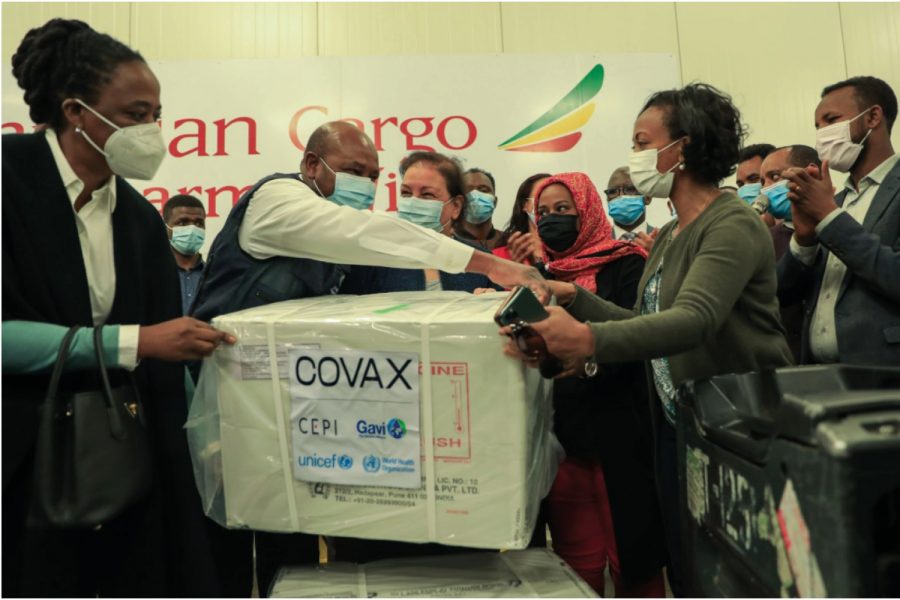High-income countries currently hold 4.2 billion doses of vaccines, while low-income countries carry fewer than 670 million doses, per the World Health Organization.
Social Studies Teacher Becky Mason said COVID-19 has further exposed wealth disparity around the world through vaccine efforts.
“There is so much inequity that has become made really apparent by this pandemic that this is just one more of all the other [inequities] that seem to be there,” she said.
However the World Health Organization has started a global health initiative COVAX which extends and supplies COVID-19 vaccines to low-income countries. According to the COVAX website, the program’s goal is to ensure an equitable supply of vaccines around the world; it plans to deliver at least 2 billion doses to 190 countries in less than one year.
Furthermore, according to the BBC, COVAX aims to supply enough shots to vaccinate 20% of the population in each participating country by the end of 2021. Most of the countries are centered in Africa, Asia and Latin America.
Ellie Mankarious (’21) said because low-income countries already handle a surplus of other problems, it is crucial that high-income countries offer support.
“These developed countries that have billions and billions of dollars and can’t even solve the problems for their own people, so go to a war-torn country or a country that is in a humanitarian crisis, there’s no way that they’re going to be able to fund or prioritize COVID-19 and vaccine distribution when they have bigger problems to deal with,” she said.
In addition, Darren Morris (’23) said COVAX is imperative as it allows fair access to vaccines.
“It’s really, really good that there’s programs like COVAX out there that are trying to level the playing field so that people in middle and lower-income countries have just as much opportunity to be vaccinated as higher-income countries,” he said.
Knowing the wealth disparity between the developed countries and the less-developing countries, I just can’t help thinking that they should definitely be doing more,
— Ellie Mankarious ('21)
According to the BBC, the COVAX program is co-led by the WHO, the Global Vaccine Alliance and the Coalition for Epidemic Preparedness Innovations. The program is also partnered with Unicef, which helps deliver the vaccines.
Moreover, both the U.K. and the U.S. governments have contributed to COVAX, per BBC. The U.S. immediately donated $2 billion Feb. 12 and will provide the remaining $2 billion over the course of the next two years as other nations also fulfil their pledges. The U.K. government has already provided $734 million in aid.
Mason said the distribution of COVAX vaccines is complicated as it poses various questions to the validity of the solution.
“It’s such a multifaceted issue because I can’t think of a solution beyond money, even though money doesn’t necessarily fix the actual problem,” she said. “Instead of solely donating money, they can help with how the manufacturing plants are going to actually produce and deliver the vaccines.”
Furthermore, Mankarious said while she appreciates the U.S. and the U.K. are helping developing countries, they could be doing more.
“Knowing the wealth disparity between the developed countries and the less-developing countries, I just can’t help thinking that they should definitely be doing more,” she said.
Although COVAX has support, it remains underfunded. According to the BBC, the program has raised $6 billion to this point. However, it needs at least another $2 billion in order to meet its target goal by the end of 2021.
It really exposed and shows the massive gaps between developing and developed nations and also the inequality, in a sense, around the world,
— Santiago Londono ('23)
Mankarious said she is not shocked to hear COVAX is at risk of not meeting its goals.
“During times of stability, we like to think – and obviously this is a generalization – but we like to think that we … put so much money and all funding towards helping them but the reality is shown during times of instability,” she said.
According to the BBC, the WHO states that putting an end to COVID-19 requires 70% of the world population to be vaccinated. At a distribution rate of 2 billion doses per year, it could take at least two years to vaccinate 70% of the world’s estimated 7.8 billion people.


Colombia is one example of COVAX’s initiative to provide equal access to vaccines. In early March, Columbia was the first country in the Americas to receive aid through the program, receiving around 117,000 of the Pfizer/BioNTech vaccine, per the WHO. With 2.31 million cases and over 60,000 deaths in Colombia, President Iván Duque said the nation is in desperate need of a productive vaccination program.
Colombia expects to receive an additional 20 million doses of the vaccine through COVAX by the end of 2021, per the WHO. Duque said he hopes to start vaccinating healthcare workers and the elderly.
Santiago Londono (’21), who is from Colombia, said it is crucial to supply less developed countries with resources since many hospitals and programs are generally underfunded.
“There’s a lot of areas in Colombia where there’s not a lot of access to even basic things, like medicine and all those basic needs,” he said. “Now with COVID around, I think it’s great having a program to help areas like Colombia that don’t have as much access to vaccines.”
Londono also said his relatives were heavily impacted by the pandemic.
“I have grandparents in Colombia and COVID was quite bad there so they had to leave the city to stay in their house in the mountains, just because it’s a lot safer,” he said. “The medical care in the cities where my grandparents live is very underdeveloped, so that was especially a main concern.”
Moreover, Londono said while his grandparents are still waiting for their COVAX doses, his parents, who live in the U.K., have already received theirs. To him, this “shocking” disparity evidences a deeper global issue.
“It really exposed and shows the massive gaps between developing and developed nations and also the inequality, in a sense, around the world,” he said.
This story was originally published on The Standard on March 30, 2021.





























![IN THE SPOTLIGHT: Junior Zalie Mann performs “I Love to Cry at Weddings,” an ensemble piece from the fall musical Sweet Charity, to prospective students during the Fine Arts Showcase on Wednesday, Nov. 8. The showcase is a compilation of performances and demonstrations from each fine arts strand offered at McCallum. This show is put on so that prospective students can see if they are interested in joining an academy or major.
Sweet Charity originally ran the weekends of Sept. 28 and Oct. 8, but made a comeback for the Fine Arts Showcase.
“[Being at the front in the spotlight] is my favorite part of the whole dance, so I was super happy to be on stage performing and smiling at the audience,” Mann said.
Mann performed in both the musical theatre performance and dance excerpt “Ethereal,” a contemporary piece choreographed by the new dance director Terrance Carson, in the showcase. With also being a dance ambassador, Mann got to talk about what MAC dance is, her experience and answer any questions the aspiring arts majors and their parents may have.
Caption by Maya Tackett.](https://bestofsno.com/wp-content/uploads/2024/02/53321803427_47cd17fe70_o-1-1200x800.jpg)
![SPREADING THE JOY: Sophomore Chim Becker poses with sophomores Cozbi Sims and Lou Davidson while manning a table at the Hispanic Heritage treat day during lunch of Sept 28. Becker is a part of the students of color alliance, who put together the activity to raise money for their club.
“It [the stand] was really fun because McCallum has a lot of latino kids,” Becker said. “And I think it was nice that I could share the stuff that I usually just have at home with people who have never tried it before.”
Becker recognizes the importance of celebrating Hispanic heritage at Mac.
“I think its important to celebrate,” Becker said. “Because our culture is awesome and super cool, and everybody should be able to learn about other cultures of the world.”
Caption by JoJo Barnard.](https://bestofsno.com/wp-content/uploads/2024/01/53221601352_4127a81c41_o-1200x675.jpg)






